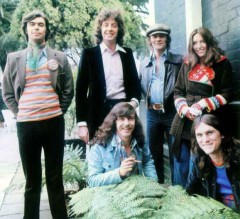Tales From The Road
Family Folk in April: Martin & Eliza Carthy

Eliza and Martin Carthy

Steeleye Span in the early 1970s
He is a giant of English folk music, a strong singer, multi-instrumentalist, and a major influence on American folk heroes Bob Dylan and Paul Simon. Martin Carthy plays traditional folk songs with a very distinctive guitar style that has made him, in the words of AllMusic’s Bruce Eder, “as much a scholar as a performer,” and a “father” and “guiding spirit” to the English folk revival of the 1960s. He has recorded as a solo artist, as a member of groups — including seminal English folk band Steeleye Span — and in many other settings. These include with his wife Norma Waterson in The Watersons, and in Waterson Carthy, which includes both his wife and his daughter Eliza, who is an established and award-winning folk performer in her own right.
On April 3, Martin and Eliza Carthy will be performing locally at Sweetwater Union High School, 2900 Highland Ave, National City. The show starts at 7:30pm and tickets are available online at the AMSD website. Advance tickets are $20 and $28, with plenty of free parking.
Martin was brought up in North London, sang in a church choir, and, not unlike a number of other future English musicians, first picked up his dad’s guitar after hearing a Lonnie Donegan record. He cites Big Bill Broonzy as his first major folk influence. In his late teens he was playing coffeehouses, and for three years was a member of a folk group called the Thameside Four before going solo as the featured singer at a London club called The Troubadour, while his reputation as a folk performer and guitarist grew.
Father Larry Bausch*, who hosts the Holy Trinity Celtic Concert Series, is a local expert on Celtic and English folk music who has staged past local appearances by Martin.
“He’s just really one of those seminal figures of the whole folk revival of the last half century,” says Bausch. “He certainly has been one of the foremost purveyors of traditional English song lore.”
Bob Dylan met Martin in late 1962 and later commented about his influence.
“Martin Carthy’s incredible. I learned a lot of stuff from Martin.” This included exposing the young American singer to many traditional English ballads, including his own arrangement of “Scarborough Fair,” a traditional song that started as a 17th century Scottish ballad. Dylan used this for much of the melody and lyrics of “Girl From the North Country” on his 1963 Freewheelin’ Bob Dylan album. The liner notes from that record also acknowledge Martin’s influence on “Bob Dylan’s Dream,” which is based on Martin’s version of “Lord Franklin.”
Martin landed a record contract in 1965 and his eponymous debut album, with fiddler Dave Swarbrick, included his arrangement of “Scarborough Fair.” The album was well received by the English folk community as were several more recorded by the two between 1966 and 1969. Around this time, in the mid-’60s, Paul Simon was living in London after the failure of his first, acoustic folk album. There he heard Martin’s arrangement of “Scarborough Fair,” and after learning the song from the man, used it as the basis for a hit Simon and Garfunkel record in 1966. When Simon failed to attribute his arrangement, a rift developed between the two and was finally settled in 2000.
As Bausch puts it, Martin “wasn’t merely performing in the traditional style, but he was keeping faith to the spirit of all of the melodies that he brought forward.”
By the 1970s Martin was one of the most popular folksingers in England and becoming a musical resource whose respect for the original versions of older, traditional songs led him to seek them out and play them in a way that rang true for a newer generation. His prowess on the acoustic guitar (he plays mandolin, electric guitar, and other instruments as well) had a lot to do with this.
“The guitar playing is a key part of it, it was not common prior to the folk revival. He was important in updating or giving a musical style that brought the tunes across,” Bausch says. “Others played traditional songs completely in the old style. To make them more musically accessible, that is one of his great gifts, and being such a talented and inventive guitarist, he was able to do that.”
The late ’60s was a critical time for the development of folk music in England. Martin, whose solo albums were a long way from the commercial folk-rock popular at the time, became, according to Eder, “a musical resource… One of Martin’s specialties was finding and completing fragments of songs that didn’t exist in complete versions.” He was also starting to record original music by select songwriters.
“Coupled with his vocal and guitar skills, all of this made [Martin] perhaps the most important folksinger in England, as a source of inspiration, a conduit for songs, and a model for how to approach the music,” Eder states.
When the folk revival hit its electric phase around 1970, two of the most important groups were Fairport Convention (which Swarbrick joined) and Steeleye Span. Fairport cofounder Richard Thompson was clearly influenced by Martin, who joined the Span, which played more traditional-oriented music. Martin played on their two 1971 albums, the second of which was played with electric instruments. Martin departed afterward to pursue more acoustic and traditional sounds.
After leaving Steeleye Span in 1972, Martin kept releasing albums, many with his wife Waterson, whom he married the same year. He also can be heard on albums as a member of Brass Monkey, starting in the 1980s, and numerous collaborations with other artists — he has played on more than 40 albums to date. Aside from his classic late ’60s albums, more recent notable solo discs include Signs of Life (1999) and Waiting for Angels (2004).
Martin’s stature is reflected in his recognition as a Member of the British Empire (MBE) in 1998. He was named Folk Singer of the Year at the BBC Radio 2 Folk Awards in 2002, then repeated the feat in 2005; he has also won recognition for individual tracks, which is well deserved, according to Bausch.
“So many people, thanks to the likes of Bob Dylan and others over the years, [Martin] has gained the respect that originally he didn’t receive, and is now generally renowned for the stature that he has had in the traditional music world, which has been great to see.”
His daughter Eliza is also no stranger to recognition; the folk music talent in her DNA has long been evident. She formed a band at 13 with her mother and cousin and soon enough was part of the folk “supergroup” Blue Murder, named by Martin, which included both of her parents at its sporadic appearances. She also wrote songs, recording solo CDs of original music, including her solo debut Heat Light & Sound from 1993. Eliza won Folk Singer of the Year at the BBC Radio 2 Folk Awards in 2003, along with an award for best traditional track. Both her 1998 album Red Rice and 2003 album Anglicana were nominated for the Mercury Music Prize for UK album of the year. Her most recent solo music is 2008’s Dreams of Breathing Underwater.
Eliza has played on many albums with one or both of her parents, including work as the trio Waterson: Carthy, with two albums, including Holy Heathens and The Old Green Man. She recorded Gift with her mother in 2010, and in 2014 sang duets with her father on The Moral of the Elephant.
The AMSD show will bring together two generations of award-winning English folk music on one stage. Martin is tagged by Eder as “the Bob Dylan of the English folk revival, without the feigned anger or the affectations, but with all of the skill and the depth.” His talent appears to have been passed along his bloodline, as Eliza’s career has bloomed. It should be a great show.
Martin & Eliza Carthy, Friday, April 3, AMSD Concerts, Sweetwater High School, 2900 Highland Ave., National City, 7:30pm. AMSD website: amsdconcerts.com
* For information on Bausch’s Celtic Concert Series call (619)-222-0365






